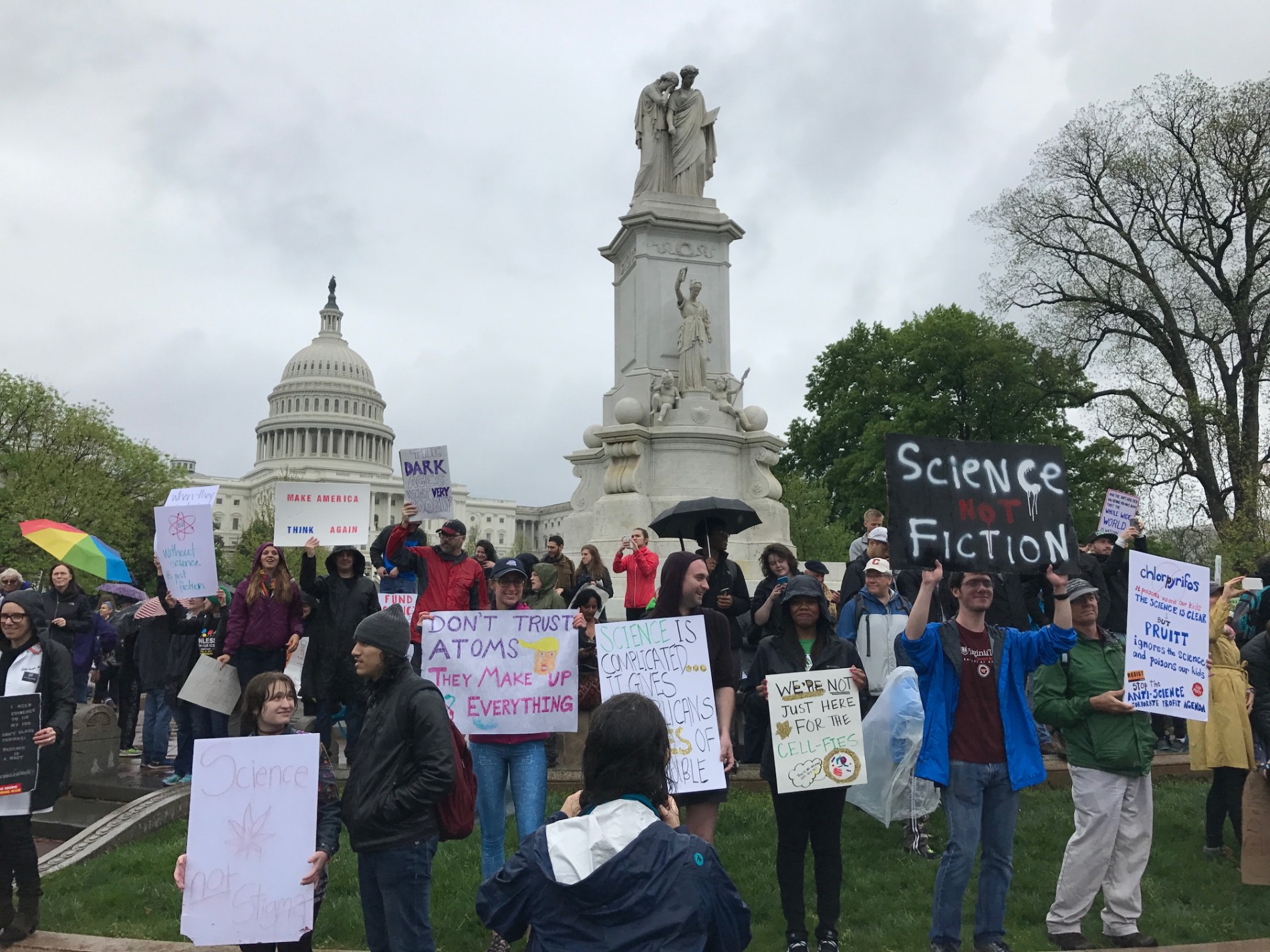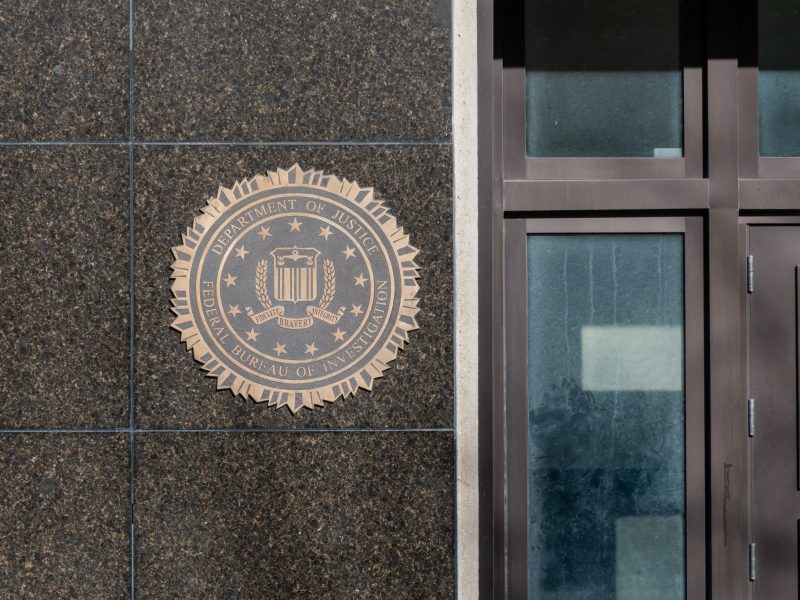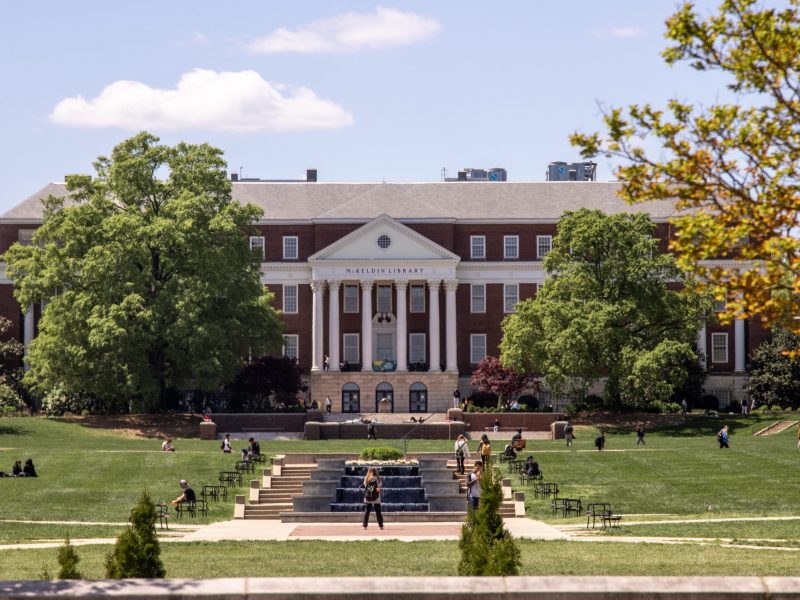Nicholas Chin held a rain-soaked sign at the intersection of Constitution Avenue and 15th Street that read, “My friend would have died to cancer if it were not for research and technology,” as the hand-written letters bled onto the white background.
Doctors detected his friend’s cancer early in her lymph nodes and were able to create a treatment plan that let her live a healthy life, said Chin, a junior psychology major.
Now, in the wake of President Trump’s budget plan that proposes massive cuts to research agencies — the same organizations that have propelled life-saving cancer treatments forward — Chin and other university students gathered with thousands in Washington under dreary skies to participate in the March for Science.
University of Maryland President Wallace Loh joined the throng of marchers. Loh encouraged the College Park community to participate in the march with a campuswide email April 17.
“It’s all for science and to support science,” Loh said at the march. “It’s important to our future and to our country.” He added that he hoped elected officials would take notice of the crowds and continue to support research funding.
Virginia Meehan, this university’s federal relations director, said the university administration is worried about the proposed cuts to federal research programs, which she dubbed the “lifeblood of [the] science programs at this university.”
“It’s really a key to our mission as a university,” Meehan said. “We are concerned and we are here to advocate for those programs and work with our members of Congress to make sure those get funded in the coming year.”
This university provided buses from Stamp Student Union to Prince George’s Plaza Metro Station, shuttling students throughout the day to and from the march.
Protesters, carrying bright posters that defended the sciences and took jabs at the Trump administration, crowded the National Mall. Several signs called to “Make America Think Again” and noted that “Science is Not an Alternative Fact.”
Neon pink “pussyhats,” remnants from the Women’s March that took place the day after Trump’s inauguration, were peppered throughout the crowd. But a new trend competed for attention: knitted hats resembling the human brain.
[Read more: “Moving and beautiful”: UMD students join 500,000 for Women’s March on Washington]
A hesitant optimism took hold over the crowd. Students were motivated to march to defend programs they felt were under siege.
“Our new government setup is really scary,” said Olivia Durling, a junior public health science major. “It seems like science, especially regarding climate change, isn’t valued in the new administration, and as someone who is going to be entering the science field and cares about both science and social issues, I feel like it’s our job as students to mobilize.”
Willem Klajbor, a junior economics and environmental science and policy major, said the protest was a march for truth, adding that he felt like some in powerful positions are trying to quiet the voices of people who are doing good.
“It doesn’t just hurt us now, but it’s going to hurt our kids, and our kids’ kids,” Klajbor said. “A lot of these issues that we’re facing right now, like climate change [and] antibiotic resistance, we don’t really have time to waffle on.”
Concerns about the Environmental Protection Agency drove many university students to take to the streets of the nation’s capital. Scott Pruitt, the new head of the agency, has sued the organization he now oversees more than a dozen times and has made statements regarding climate change that directly contradict the findings of the EPA.
“Humans have been destroying the planet since the Industrial Revolution,” said Emma Holmes, a senior mechanical engineering and computer science major. “The EPA has helped reverse some of the effects, but now that the [proposed] budget has been cut, there’s just a lot less hope for scientists that we’re going to be able to eventually save the planet.”
That didn’t stop the crowd. The sea of umbrellas masked their optimistic faces, but not their voices, as they chanted “EPA” as they walked past the government building. A girl stood above the crowd holding a sign that read, “Girls Just Want to Have Funding for the EPA,” drawing laughter from passersby.
[Read more: A team of UMD sociology professors launched a fundraiser to study D.C. protests]
Darryll Pines, engineering school dean, stressed the importance of evidence-based scholarship in policy making.
“We are all concerned about the proposed budget because it sort of has the appearance that there’s a lack of understanding, a lack of commitment, to science,” Pines said. “It concerns many people, especially in the various agencies, like in the department of energy, also in climate science [and] in NASA.”
Many of these proposed cuts could affect not only the faculty, but also the students studying at this university. Quinn Kupec, a freshman aerospace engineering major, works on a high-altitude balloon research program funded partially through NASA. Concerned about research cuts, he joined other members of his lab to voice his support for science.
However, Kupec remained unsure of whether the march would sway the Trump administration.
“Whether the White House will take notice or not, I don’t know,” Kupec said. “I think Congress will have to.”
Kupec’s statement echoed the concerns of others, who were worried Trump’s administration would disregard the protest.
“I don’t know if they will,” said Holmes, getting ready to board a university shuttle bus back to campus. “But one can hope.”
Students on the shuttle clutched their signs in silence. Even though the rain damaged their paper and blurred the outlines of the letters, their messages could still be read.
“We’ll still be able to make changes,” Holmes said.



